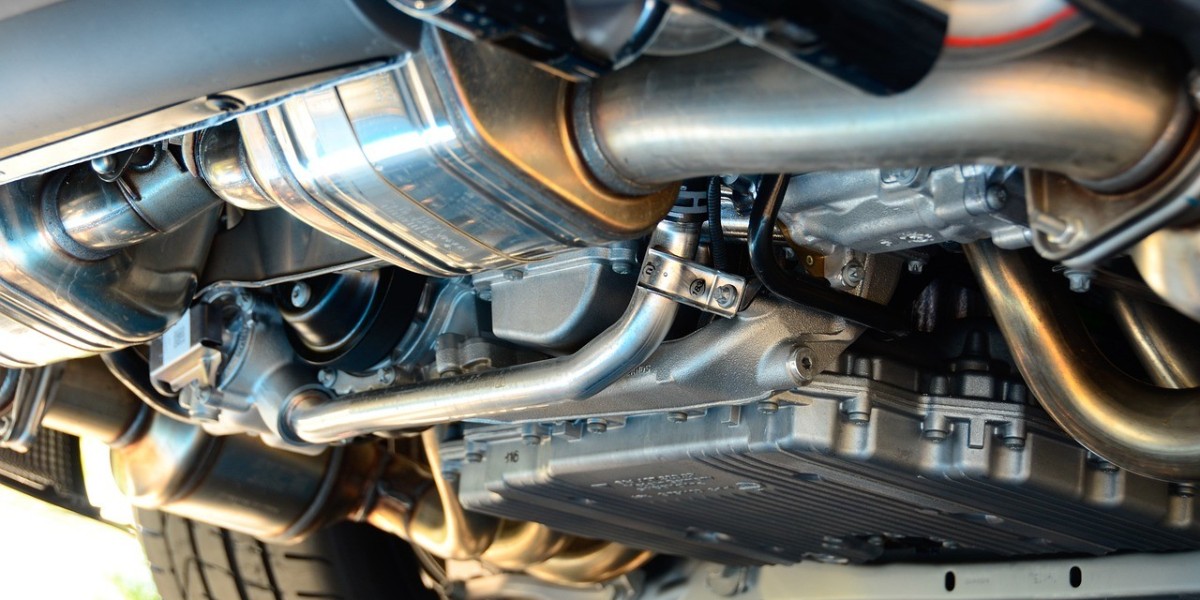An aftermarket exhaust system refers to performance upgrades to an exhaust system that is not manufactured by the original equipment manufacturer (OEM) but is instead produced by third-party companies. These systems are installed in place of or in addition to the factory-installed exhaust system and are typically used in cars, motorcycles, or other vehicles.
Here is what an aftermarket exhaust system does:
- Improves Performance
- Increased horsepower and torque: Aftermarket systems are often designed with larger diameters and smoother tubing, which reduces exhaust backpressure. This allows the engine to expel exhaust gases through the downpipes more efficiently, which can lead to gains in horsepower and torque.
- Better exhaust flow: These systems often have fewer restrictions, enhancing the flow of gases from the engine, leading to more effective combustion.
- Enhances Sound
- Sportier or louder exhaust note: Many aftermarket systems, like catless downpipes, are designed to amplify or alter the exhaust sound. For enthusiasts, this results in a more aggressive, sporty sound compared to the often quieter factory systems.
- Reduces Weight
- Lighter materials: Many aftermarket exhaust systems are made from materials like stainless steel or titanium, which are lighter than the stock system. This weight reduction can improve overall vehicle performance, particularly in sports cars and motorcycles.
- Customization
- Tailored to specific needs: Aftermarket systems come in a variety of designs, allowing users to select one that suits their preferences, whether they prioritise sound, performance, or aesthetics.
- Improved Aesthetics
- Enhanced appearance: These systems often come with polished tips or unique designs that can enhance the vehicle’s appearance.
However, installation of an aftermarket exhaust system may affect the vehicle's emissions compliance, so it is important to check local regulations before modifying the exhaust.
Are all aftermarket exhaust systems the same?
No, not all aftermarket exhaust systems are the same. They can differ in design, materials, performance benefits, sound characteristics, and the way they interact with a vehicle's engine. Here are the key differences between various types of aftermarket exhaust systems:
- Type of System
- Cat-back: Replaces everything from the catalytic converter to the tailpipe. This is one of the most common types and often provides performance gains without affecting emissions compliance.
- Axle-back: Only replaces the exhaust system components from the rear axle to the tailpipe, primarily affecting sound but offering minimal performance gains.
- Header-back: Replaces the entire exhaust system from the headers back. This type provides the most significant performance improvements but is more complex to install and may require additional modifications.
- Material
- Mild steel: Cheaper but more prone to rust, often used in budget aftermarket systems.
- Stainless steel: Durable and resistant to rust, often used in high-quality systems and suitable for all-weather conditions.
- Titanium: Lightweight and extremely durable, but also expensive, typically found in premium systems designed for high-performance vehicles.
- Design
- Straight-through (or "glasspack") mufflers: These allow for very little backpressure and produce a louder, more aggressive sound. They are designed for performance.
- Chambered mufflers: These have internal chambers that reflect sound waves, producing a more controlled exhaust tone while offering moderate performance gains.
- Turbo-style mufflers: Feature multiple perforated tubes to reduce sound while still offering moderate performance improvements.
- Performance Focus
- Sound-focused systems: Some aftermarket exhaust systems are designed primarily to enhance the sound of the vehicle, without major performance changes.
- Performance-focused systems: These systems optimise exhaust flow to improve horsepower and torque, and may also enhance sound.
- Balanced systems: Offer a combination of performance improvements and sound enhancement.
- Sound Characteristics
- Aggressive/loud: Some systems are engineered to make the exhaust note much louder and sportier. Enthusiasts often choose these for a more noticeable sound.
- Moderate: Others are designed to increase sound volume slightly but keep it refined for daily driving.
- Quiet/subtle: For those who do not want a loud exhaust, some systems prioritise performance while maintaining a relatively quiet exhaust note.
- Fitment
- Universal fit: Some systems are designed to fit a wide variety of vehicles but may require additional modifications.
- Vehicle-specific fit: These systems are tailored for specific makes and models, ensuring easier installation and optimal performance.
- Brand and Price Range
- High-end brands: Known for superior materials, craftsmanship, and tuning, such as Akrapovič, Borla, and MagnaFlow.
- Mid-range brands: Offer a balance of price and performance, like Flowmaster or MBRP.
- Budget brands: More affordable but may use lower-quality materials and offer less performance, often seen with generic or off-brand systems.
- Regulatory Compliance
- Emissions compliance: Some systems are designed to meet specific emission standards, especially in regions with strict environmental regulations (e.g., California’s CARB standards).
- Off-road or track use: Others may not comply with emissions standards and are intended for use in racing or off-road applications.
These factors make it important to choose an aftermarket exhaust system based on your priorities—whether it is performance, sound, appearance, budget, or compliance.
Downsides to installing an aftermarket exhaust system
While installing an aftermarket exhaust system can provide benefits such as increased performance, better sound, and improved aesthetics, there are also several potential downsides to consider:
- Increased Noise
- Excessive noise: Some aftermarket exhaust systems can make the vehicle significantly louder than the stock exhaust, which may be annoying or impractical for daily driving. In some areas, excessive noise could lead to fines or violations of local noise ordinances.
- Drone inside the cabin: Certain exhaust systems can cause unwanted noise or “drone” inside the vehicle, particularly at highway speeds, which can be tiring for long drives.
- Potential Legal and Regulatory Issues
- Emissions compliance: Many aftermarket systems, especially those that modify or remove the catalytic converter, may not meet emissions regulations in certain areas. For instance, California’s CARB (California Air Resources Board) regulations are strict, and using non-compliant exhaust systems can result in fines or failing emissions inspections.
- Noise restrictions: Some regions have specific laws regarding the decibel level that an exhaust system can produce. Aftermarket systems that exceed these limits may be illegal.
- Reduced Fuel Efficiency
- Loss of fuel efficiency: Depending on the type of aftermarket exhaust installed, some systems can negatively impact fuel economy. For instance, systems that prioritise performance or sound over efficiency may cause the engine to use more fuel.
- Warranty Issues
- Voiding the warranty: In some cases, installing an aftermarket exhaust system may void certain aspects of the vehicle’s warranty, especially if it is a significant modification. This is particularly relevant for newer vehicles still under the manufacturer’s warranty.
- Cost
- High initial cost: High-quality aftermarket exhaust systems made from premium materials like stainless steel or titanium can be expensive. In addition, labour costs for installation can add up, especially if modifications or custom fitment are needed.
- Potential repair costs: If an aftermarket system is improperly installed or of lower quality, it can lead to damage to other components of the vehicle, resulting in costly repairs down the road.
- Reduced Resale Value
- Lower resale appeal: Not all buyers may appreciate a loud or highly modified vehicle. Installing an aftermarket exhaust could make it harder to sell the car, or you might have to remove the system and revert to stock before selling.
- Potential devaluation: Some aftermarket systems might be viewed negatively by dealerships or future buyers who prefer vehicles to be closer to factory specifications.
- Installation Challenges
- Improper fitment: Some aftermarket systems, particularly universal ones, may not fit perfectly on your vehicle, leading to rattling, leaks, or the need for additional modifications.
- Professional installation required: While some people may attempt to install an aftermarket exhaust system themselves, doing so can be complex and may require professional installation, adding to the overall cost.
- Risk of Performance Issues
- Over-optimisation for sound or aesthetics: Some aftermarket exhaust systems prioritise sound or appearance over performance, which could actually lead to a decrease in power if not properly designed for your specific vehicle.
- Increased backpressure: Poorly designed systems can create unwanted backpressure, which may result in reduced engine performance rather than improvements.
- Insurance Concerns
- Higher insurance premiums: Some insurance companies may raise premiums for modified vehicles, particularly if the modifications are seen as increasing the likelihood of theft, damage, or accidents.
Before installing an aftermarket exhaust system, it is important to weigh the potential drawbacks against the benefits and ensure that the system you choose is compatible with your vehicle and legal in your area.



